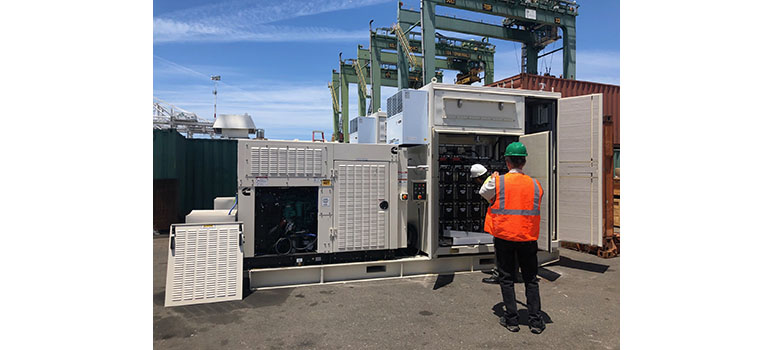About three months into a plan to cut emissions at the Port of Oakland by replacing traditional diesel-burning crane engines with state-of-the-art hybrid engines, port tenant SSA Marine said last month that even it has been surprised by the difference the new engines are already making.

The engines on the Port of Oakland’s massive, 90-foot cranes are being replaced with new hybrid engines. All 13 cranes should be updated by next summer.
BY BILL PICTURE
Published: August, 2019
About three months into a plan to cut emissions at the Port of Oakland by replacing traditional diesel-burning crane engines with state-of-the-art hybrid engines, port tenant SSA Marine said last month that even it has been surprised by the difference the new engines are already making.
To date, only three crane engines have been swapped out for hybrid engines, but based on the results thus far, SSA projects a 96 percent reduction in greenhouse gas emissions and a 95 percent reduction in diesel particulate matter emissions when the other 10 cranes at its Oakland International Container Terminal have been retrofitted. That’s expected to happen by next June.
“This is way better than we thought it would be,” said SSA Crane Manager Ken Larson. “So far, this is a very successful project.”
The massive, 90-foot-tall cranes are widely considered to be the workhorses of marine terminals, stacking rows of inbound containers that await pickup by drayage trucks and outbound containers that await loading onto seagoing vessels. Together, the 13 cranes at the Oakland International Container Terminal lift about 1,000 containers each day.
Because gantry cranes are veritable fixtures at every active port in the world, maritime officials are keeping a very close eye on the hybrid conversion project. Success resulting from the employing of new hybrid technology at the Port of Oakland could in theory be replicated industry-wide.
The biggest obstacle is cost. A $5 million grant awarded to SSA by the Bay Area Air Quality Management District covered the majority of the project’s $6 million price tag.
“They’re expensive pieces of equipment,” said Port of Oakland Communications Director Mike Zampa. Zampa was unable to provide an actual cost for each hybrid engine, but said that the last time the industry got this excited about crane-related emissions was a few years ago when cleaner-burning diesel engines became all the rage.
Back in 2015, the Environmental Protection Agency awarded money to another port tenant, TraPac, to give four of its cranes new engines that complied with then-new Tier 4 diesel engine standards. That’s still the strictest EPA emissions requirement for off-highway diesel engines. “I’d call that an ‘upgrade,’” Zampa said. “This is not an upgrade. It’s an ‘overhaul.’”
Win-win-win
Zampa pointed to the money that the hybrid engines are saving SSA longer-term as evidence that the switch to hybrid blows Tier 4-compliant engine upgrades out of the water.
“I hesitate to call it a win-win; but it’s a double-win, for sure,” he said. “The significant reduction in greenhouse and diesel particulate emissions—that’s victory number one. But the fuel cost savings are also really significant, dramatically significant.”
Ken Larson says the old diesel-burning crane engines—1,000 horsepower behemoths compared to the 142-horsepower engines used only to recharge a crane’s batteries—consumed 10 to 12 gallons of diesel every hour. The new hybrid engines only use about a half-gallon per hour. Less gas used means fewer emissions and lower fuel costs.
“That’s the nuts and bolts of air emissions savings right there,” Larson said. “And we’re astonished by the results.”
“And the hybrid engines are much cheaper to maintain than the old diesel engines, so there’s additional savings to be had there too,” Zampa added. “That’s always the best kind of story for the environment: air quality is being improved while the company saves money doing it.”
The hybrid conversion project folds nicely into the Port of Oakland’s master plan to reduce emissions (specifically, diesel particulate emissions) by 85 percent by the year 2020. The port’s last report showed diesel particulate emissions were down 81 percent. “We’re confident we’ll hit that goal,” said Zampa.
The port is so confident, in fact, that it’s already begun working on a post-2020 to-do list. Earlier this summer, the port released its “Seaport Air Quality 2020 and Beyond” plan, which presents a path to zero emissions. You read that right—zero emissions.
“We’re going after the rest of it; 85 percent isn’t good enough,” Zampa explained. “We have neighbors. They deserve clean air. And our employees and tenants and business partners—they all deserve clean air. “
The port is also looking at how to accommodate and foster port business growth with the wellbeing of these and other stakeholders at the forefront of its mind. The “Growth with Care” plan announced in March 2018 effectively says that port growth is of little value to anyone if it doesn’t benefit everyone.
Key tenets of the five-year plan include working to curb diesel emissions and creating jobs that will stimulate the local economy. “The plan supposes two things: One, that we will continue to increase business at the port; and two, that we will benefit our community, not harm it,” Zampa said.
“That’s why there’s a continual emphasis on sustainability and emission control, water control and traffic control,” he said. “It’s our responsibility as good neighbors and good corporate partners.”
All photos courtesy of Port of Oakland

Based on results so far, changing the Port’s cranes over to hybrid engines is projected to reduce greenhouse gas emissions by 96 percent and diesel particulates by 95 percent.

The new hybrid engines use much less fuel because they are used only to recharge the crane’s batteries.

